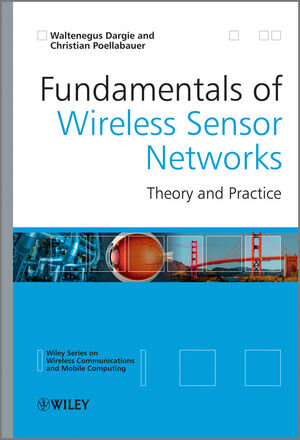Fundamentals of Wireless Sensor Networks
Theory and Practice
von Waltenegus Dargie und Christian PoellabauerIn this book, the authors describe the fundamental concepts andpractical aspects of wireless sensor networks. The book provides acomprehensive view to this rapidly evolving field, including itsmany novel applications, ranging from protecting civilinfrastructure to pervasive health monitoring. Using detailedexamples and illustrations, this book provides an inside track onthe current state of the technology. The book is divided into threeparts. In Part I, several node architectures, applications andoperating systems are discussed. In Part II, the basicarchitectural frameworks, including the key building blocksrequired for constructing large-scale, energy-efficient sensornetworks are presented. In Part III, the challenges and approachespertaining to local and global management strategies are presented- this includes topics on power management, sensor nodelocalization, time synchronization, and security. At the end ofeach chapter, the authors provide practical exercises to helpstudents strengthen their grip on the subject. There are more than200 exercises altogether.
Key Features:
* Offers a comprehensive introduction to the theoretical andpractical concepts pertaining to wireless sensor networks
* Explains the constraints and challenges of wireless sensornetwork design; and discusses the most promising solutions
* Provides an in-depth treatment of the most criticaltechnologies for sensor network communications, power management, security, and programming
* Reviews the latest research results in sensor network design, and demonstrates how the individual components fit together tobuild complex sensing systems for a variety of applicationscenarios
* Includes an accompanying website containing solutions toexercises (http://www. wiley. com/go/dargie_fundamentals)
This book serves as an introductory text to the field ofwireless sensor networks at both graduate and advancedundergraduate level, but it will also appeal to researchers andpractitioners wishing to learn about sensor network technologiesand their application areas, including environmental monitoring, protection of civil infrastructure, health care, precisionagriculture, traffic control, and homeland security.
Key Features:
* Offers a comprehensive introduction to the theoretical andpractical concepts pertaining to wireless sensor networks
* Explains the constraints and challenges of wireless sensornetwork design; and discusses the most promising solutions
* Provides an in-depth treatment of the most criticaltechnologies for sensor network communications, power management, security, and programming
* Reviews the latest research results in sensor network design, and demonstrates how the individual components fit together tobuild complex sensing systems for a variety of applicationscenarios
* Includes an accompanying website containing solutions toexercises (http://www. wiley. com/go/dargie_fundamentals)
This book serves as an introductory text to the field ofwireless sensor networks at both graduate and advancedundergraduate level, but it will also appeal to researchers andpractitioners wishing to learn about sensor network technologiesand their application areas, including environmental monitoring, protection of civil infrastructure, health care, precisionagriculture, traffic control, and homeland security.







